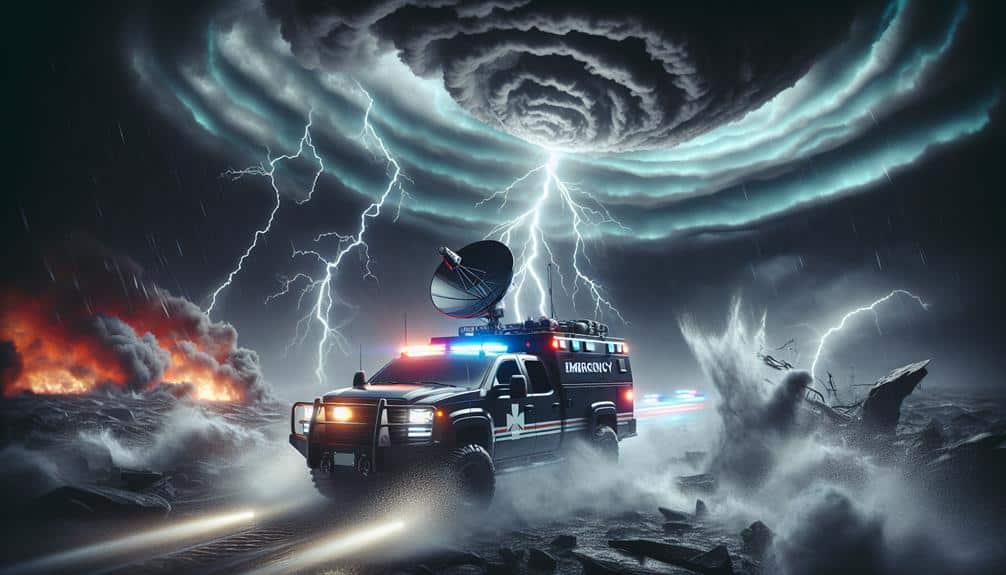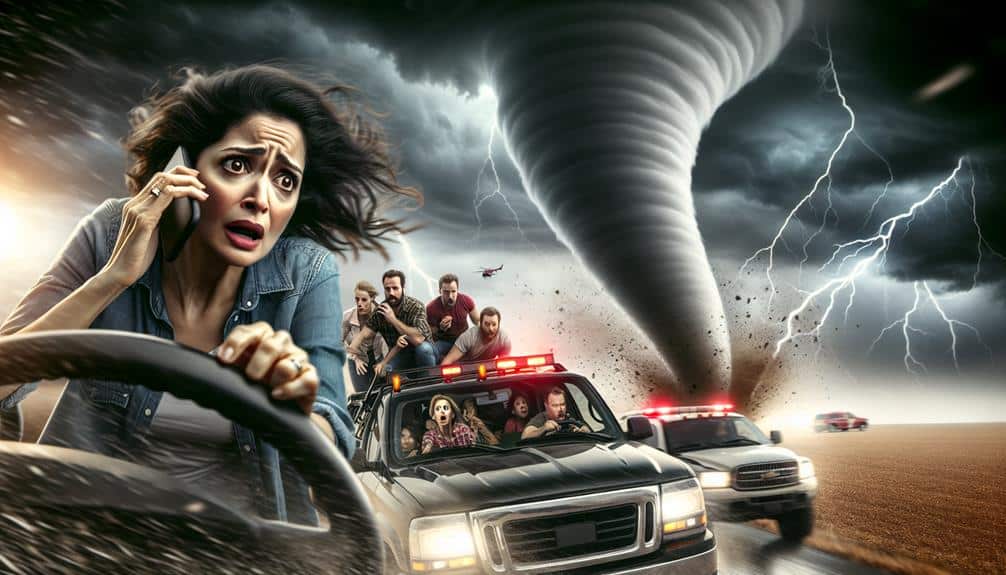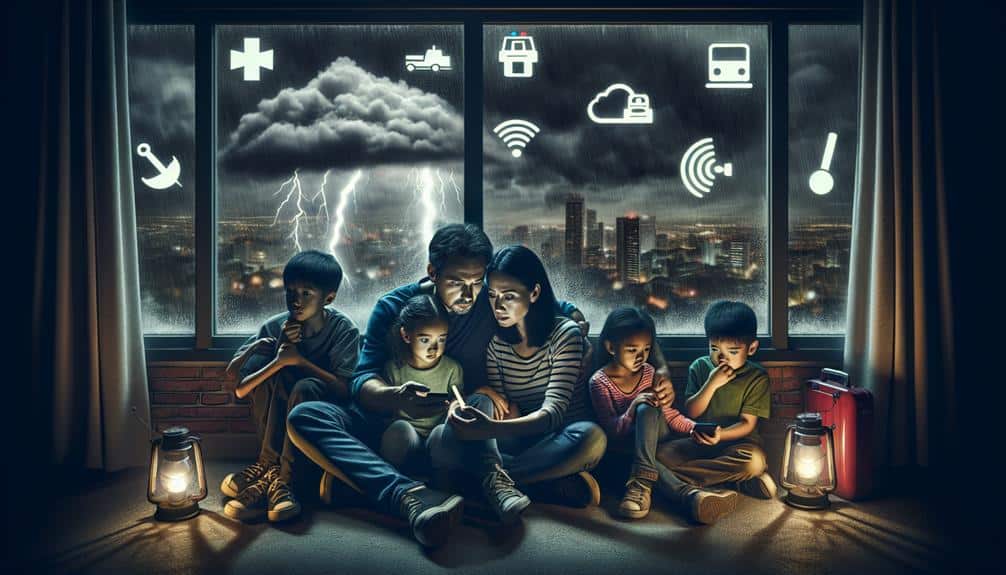We depend on satellite phones, two-way radios, mobile apps, social media, and emergency beacons for rapid storm chaser communication. Satellite phones guarantee connectivity in remote areas with real-time weather updates. Two-way radios offer instant, reliable communication over short distances with strong signals. Mobile apps provide GPS tracking, messaging, and meteorological data. Social media enables us to share real-time observations and engage with the community. Emergency beacons transmit distress signals and pinpoint locations through GPS. Combining these tools enhances our operational efficiency and data collection capabilities. Explore how each method plays an essential role in our strategy.
Key Points
- Two-way radios offer instant push-to-talk communication over short distances.
- Mobile apps provide real-time data, GPS tracking, and instant messaging.
- Satellite phones ensure reliable communication in remote areas.
- Social media allows for immediate dissemination of updates and observational data.
Satellite Phones
Satellite phones provide storm chasers with a reliable communication method, enabling connectivity in remote areas where traditional cellular networks fail. With satellite phones, we can continuously receive real-time weather updates, a critical component for tracking volatile storm systems. These devices bypass terrestrial limitations by linking directly with orbiting satellites, ensuring that we're never out of touch, even in the most isolated locations. This capability empowers us to make informed decisions based on the latest meteorological data, greatly enhancing our operational efficiency.
When we're out in the field, the ability to relay field reports instantaneously can be the difference between life and death. Satellite phones enable us to communicate our exact positions, storm trajectories, and observed weather phenomena back to our teams and meteorological organizations. This data-driven approach ensures that our field reports are accurate, timely, and actionable. The reliability of satellite phones in delivering these reports can't be overstated; they're indispensable tools that contribute to the broader understanding of storm behavior and dynamics.
For those of us who crave the freedom to chase storms without the constraints of cellular network coverage, satellite phones offer an unparalleled communication solution.
Two-Way Radios
While satellite phones offer global reach, two-way radios provide a fast and reliable means of communication over shorter distances, enabling us to coordinate closely with our immediate team during storm chases. These devices excel when it comes to signal strength and communication range, allowing us to maintain real-time updates and make split-second decisions.
Two-way radios, particularly those operating on UHF (Ultra High Frequency) and VHF (Very High Frequency) bands, offer robust signal strength, which is essential when maneuvering through areas with varying topography and weather conditions. The communication range of these radios can extend up to 30 miles under ideal conditions, though actual range may vary depending on obstructions such as buildings and mountains.
They are designed for quick, push-to-talk communication, eliminating the delays associated with dialing numbers or waiting for connections. This immediacy is crucial for storm chasers needing to broadcast warnings or updates instantly. Additionally, two-way radios are less susceptible to network congestion, a common issue with cellular networks during severe weather events.
Concerning power efficiency, these radios can operate for extended periods on a single charge, ensuring we remain connected throughout our chase. Their durability and reliability make them indispensable tools in our storm-chasing arsenal.
Mobile Apps
Mobile apps have revolutionized storm chaser communication by providing real-time data, GPS tracking, and instant messaging capabilities. We now have the ability to access meteorological information, storm paths, and radar imagery in real time. This immediate access to data facilitates rapid decision-making, allowing us to stay ahead of severe weather conditions.
One of the critical features of these apps is GPS tracking. By sharing our precise location, we can coordinate with fellow storm chasers and emergency services more effectively. This real-time location data guarantees that we can avoid redundant coverage and maximize our observational reach.
Additionally, instant messaging within these apps allows for streamlined communication, eliminating the delays often associated with traditional methods.
Data-driven apps like RadarScope, Storm Shield, and MyRadar provide detailed radar imagery and storm tracking capabilities. These tools offer high-definition radar data, customizable alerts, and predictive analytics, empowering us to make informed decisions.
The efficiency of mobile apps lies in their integration of multiple functionalities into a single platform.
Social Media
Social media platforms have emerged as essential tools for storm chasers to disseminate real-time updates, share observational data, and coordinate logistics. By leveraging platforms like Twitter, Facebook, and Instagram, we can broadcast critical information instantaneously. Live streaming on these platforms allows us to provide real-time visuals and updates, enhancing situational awareness for both the public and fellow storm chasers.
Our ability to engage with the community through social media is unparalleled. We can quickly share high-resolution images, videos, and meteorological data, promoting immediate feedback and collaborative analysis. Platforms such as Twitter facilitate rapid dissemination of warnings and updates, thanks to their concise format and wide reach. Utilizing hashtags and geotags, we can target specific regions and audiences, ensuring that our information reaches those in the path of the storm.
Moreover, social media fosters a dynamic environment for community engagement. It enables real-time interaction with meteorologists, emergency responders, and other storm chasers, creating a collaborative network that bolsters our collective understanding and response. This interconnectedness not only aids in our immediate mission but also contributes to long-term data collection and analysis, ultimately enhancing our predictive capabilities and preparedness strategies.
Emergency Beacons

How can we secure our safety and communication integrity during severe weather events? Emergency beacons provide a robust solution. These devices are critical for storm chasers who need reliable, immediate communication channels when traditional methods fail. Emergency beacons operate on dedicated frequencies, guaranteeing that our distress calls get through even in the most dire circumstances.
Utilizing emergency beacons, we can transmit emergency signals that cut through the noise of a storm. Here's what makes them indispensable:
- Signal Flares: Visual cues for aerial or ground search teams.
- Morse Code: Simple, yet effective, for relaying precise distress calls.
- GPS Integration: Pinpoints our exact location, enhancing rescue accuracy.
Emergency beacons aren't just about sending out a distress signal; they're about securing our message is received and acted upon swiftly. The integration of Morse code allows us to communicate even when verbal communication is impossible.
Signal flares offer a visual confirmation for rescuers, while GPS capabilities ensure that we're found quickly and efficiently. By leveraging these technologies, we enhance our operational safety and maintain our freedom to chase storms without compromising our well-being.
Frequently Asked Questions
How Do Storm Chasers Track Storms in Remote Areas Without Cellular Coverage?
We track storms in remote areas without cellular coverage by using satellite phones and communication relays. These tools provide reliable data transmission, ensuring we stay connected and informed, even in the most isolated locations.
What Are the Primary Safety Protocols for Storm Chasers in the Field?
Exploring nature's fury, we prioritize safety measures like real-time weather data, GPS tracking, and emergency response plans. These protocols guarantee we can chase the storm while maintaining our freedom and safeguarding our lives.
How Do Storm Chasers Communicate With Local Authorities During Emergencies?
We use emergency protocols and advanced communication strategies, including direct radio channels and real-time data sharing, to coordinate with local authorities. These methods guarantee efficient information flow and quick response during storm-related emergencies.
What Essential Gear Do Storm Chasers Carry for Effective Communication?
For effective communication, we carry satellite phones and radio scanners. Satellite phones guarantee connectivity in remote areas, while radio scanners provide real-time weather updates and emergency broadcasts. These tools are essential for maintaining safety and operational efficiency.
How Do Storm Chasers Ensure Their Communications Are Not Disrupted by Severe Weather Conditions?
Coincidentally, as we chase storms, we guarantee our communications aren't disrupted by severe weather using satellite phones and emergency beacons. These devices provide reliable, uninterrupted links, essential for transmitting data and maintaining safety during extreme conditions.


